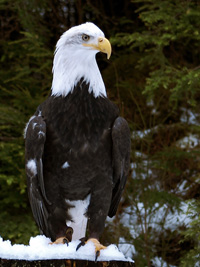Raptors are the charismatic group of birds that includes hawks, eagles, and falcons. They evoke power, swiftness, and grace. Raptors, or birds of prey, gaze calmly about while at rest, exuding confidence and nobility, and, while soaring aloft, they are absolute icons of the Alaska landscape. Raptors are commonly known as birds of prey, hunting live meat for food. raptors that are active during the day like hawks, falcons, and eagles are known as diurnal. Nocturnal birds are active during the night, and include raptors such as owls.
Three physical characteristics set raptors apart from other birds: (1) strong grasping feet with sharp talons used to seize prey, (2) a hooked or hook-tipped beak used to kill and consume prey, and (3) a diet that consists entirely of meat. Raptors also have great eyesight, but a poor sense of smell. In many ecosystems, raptors can be found near the top of the food chain, making them ideal indicators of ecosystem health.
The bald eagle of Alaska’s waterways and the soaring golden eagle of the Interior are two of this state’s most magnificent birds of prey. Long valued for their aesthetic beauty, eagles are now recognized for their biological importance as scavengers and predators in the natural environment. These raptors deserve our protection and respect.
Found only in North America, bald eagles are more abundant in Alaska than anywhere else in the United States. The Alaska population has been estimated to include 30,000 birds at the time of fledging. Bald eagles are often found along Alaska’s coast, offshore islands, and Interior lakes and rivers. The highest nesting densities occur on the islands of Southeast Alaska. Most bald eagles winter in southern Alaska, but some leave the state during cold months. In the Chilkat Valley, over 3,000 birds may congregate in late fall and early winter to feed on spawned-out salmon.
The bald eagle is so named for its conspicuous white head and tail. The distinctive white adult plumage is not attained until 5 or more years of age. Immature birds lack this easily identifiable characteristic and can be confused with the golden eagle. The immature bald eagle’s unfeathered lower legs and whitish wing linings on the forward part of the wings can be helpful distinctions where the two species coexist. The bald eagle is Alaska’s largest resident bird of prey with a wing span up to 7 1/2 feet long and weights of 8 to 14 pounds. Like many raptors, females are larger than males.
The golden eagle is named for the golden buff-colored feathers on the crown and nape of the neck. The adult body color is usually dark brown, and the dark-tipped tail is either darkly barred or spotted. Adult plumage is acquired over a three to four year period and involves a gradual reduction in the amount of white coloration. Immature golden eagles have white wing patches and white at the base of the tail. This bird has a wing span from 6 to 7 feet and weighs 8 to 12 pounds. Golden eagles are found in northern regions of the entire northern hemisphere. In Alaska, the range extends as far north as the Brooks Range with a limited and scattered distribution in Southeast and rare occurrences in the Aleutians or Alaska Peninsula. Not all eagles migrate but most go south when food supplies decline.
The northern goshawk and the sharp-shinned hawk are the Alaskan representatives of a group of hawks known as accipiters, with short, rounded wings and long tails. Both native species are abundant in the state but not commonly seen, for they spend the majority of their time in wooded habitats. When they do venture out into the open, the accipiters can be recognized easily by their “several flaps and a glide” style of flight.
Adult northern goshawks are bluish-gray on the back, wings, and tail, and pearly gray on the breast and underparts. The dark gray cap is accented by a light gray stripe above the redeye. Like most birds of prey, female goshawks are larger than males. A typical female is 25 inches long, has a wingspread of 45 inches and weighs 2¼ pounds while the average male is 19½ inches (50 cm) in length with a wingspread of 39 inches and weighs 2 pounds. Adult sharp-shinned hawks have gray backs, wings and tails (males tend to be bluish-gray, while females are browner) with white underparts barred heavily with brownish-orange. They also have red eyes but, unlike goshawks, have no eye strip. A typical female weighs 6 ounces is 13½ inches long with a wingspread of 25 inches, while the average male weighs 3½ ounces, is 10 inches long and has a wingspread of 21 inches.
In both species, immature birds are brown on the back, wings and tail, with buff-colored underpart s streaked with brown. The eyes of young accipiters are yellow; it takes several years for them to change to the red of adults. Young goshawks have a buff eye
stripe. In both species, the long tail is broadly banded with dark gray in adults and dark brown in immatures. The tail is tipped with white in adults and buff in immatures.
|
|








